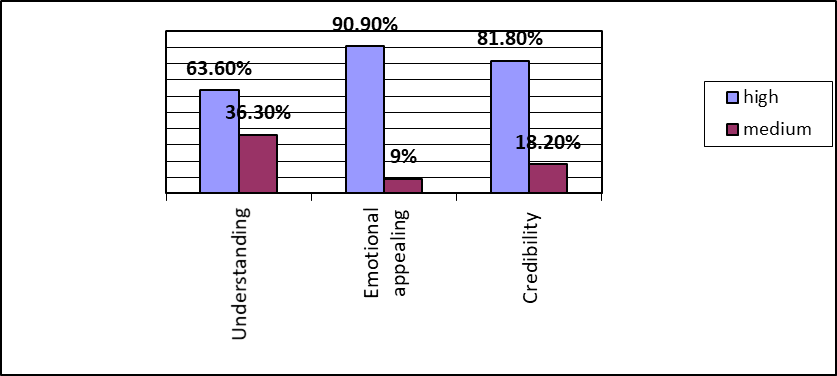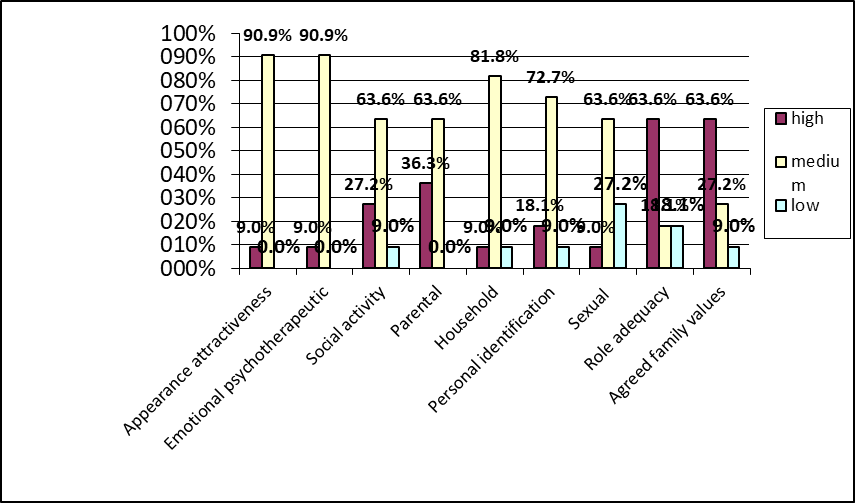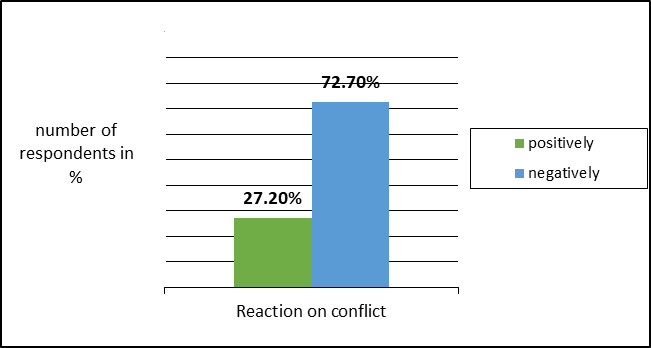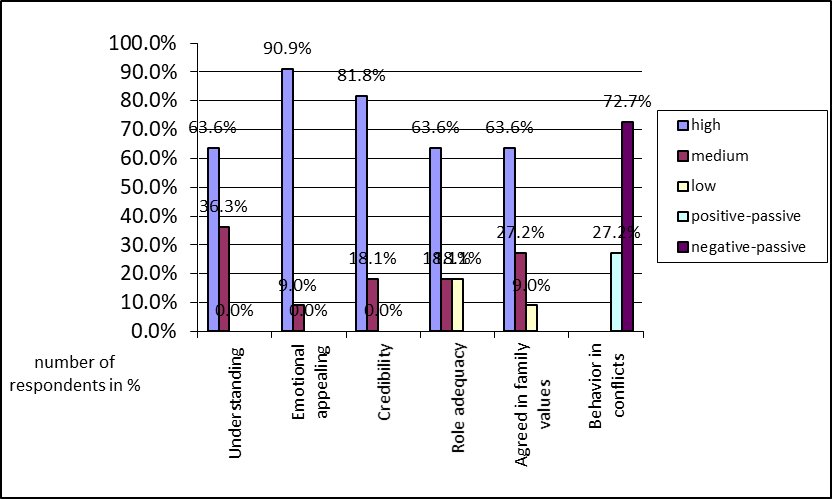Abstract
Social criteria applied to assess a marriage in part of stability are called satisfaction with marriage. The assessment to own marriage given by one of a partner is based on these criteria but remains quite subjective. Problems related to family life, their nature and character determine main functions, at fulfilling of which the family is oriented. To investigate the degree of harmonization between spouses on issues relating to the most important spheres of family life we used theoretical methods; organizational methods; empirical methods, REMP questionnaire, questionnaire detecting spouses’ behavior in conflict situations); interpretation methods. The average period of living as a family among representatives of the sampling is 14 years. The highest level is reached by indicators denoting emotional appealing and credibility, equal values in indicators illustrating understanding, role expectation and harmonization in accepting family values. At the same time, negatively passive behavior in conflict situations dominates among 72.7% of respondents. The analysis shows that the majority highly appreciates understanding, emotional appealing, creditability in their families; they are characterized as people with common values, who adequately assess a partner regarding the family roles one plays. Conflict behavior in most families can be characterized as negatively passive, misunderstanding between partners in this case puts some negative imprint on constructive conflict resolutions. The break in harmony between spouses towards main components of family life; mismatch in expectations from each other and willingness of a respondent to perform certain role functions significantly reduce the indicators of role adequacy/expectation in these families.
Keywords: Understandingemotional appealingcredibility role adequacyfamily valuesconflict situation
Introduction
The society, where a family exists, is interested in its spiritual strength, in the ability to raise healthy children, both in a biological sense and a moral one. It is the family that forms personality of a citizen, his/her value system that serves as a ground to basic family functions and as a source to life-long learning covering some important life skills and abilities, which guarantees successful adaptation in the society (Kiel & Kalomiris, 2015; Ocampo, Restubog, Liwag, Lu Wang, & Petelczyc, 2015; Priest, Woods, Maier, Parker, & Roush, 2015).
The family and its members bring their contribution to shaping and determining an individual behavior because the family acts out as a model to emotional background and behavior structure which serve as the social patterns for an individual throughout the whole life and undoubtedly puts a modifying effect on his/her behavior in a certain life period (Repetti & Wang, 2017; Romero-Ruiz, Echeverri-Sánchez, Peña-Plata, Vásquez-Giraldo, & Bran-Piedrahita, 2017; Runcan, 2012). The climate in a family and the peculiarities in family relationships constantly affect both a child and other family members, regardless the age (Sapin, Widmer, & Iglesias, 2016; Selvarajan, Singh, & Cloninger, 2016; Vandermeer, Kotelnikova, Simms, & Hayden, 2018).
Psychological atmosphere characterizing with love and care, respect and support gives to a family some advantages, compared to other social institutions, in the process of individual’s social adaptation (Balcells-Balcells, Giné, Guàrdia-Olmos, Summers, & Mas, 2019; Bozhenko, 2011; Catalano & Catalano, 2014). The individual approach to a child family education can be an effective tool only in a family just for the reason that only a family does know all about a child’s innate talents, interest, aptitudes and the family will know what conditions, inter alia individual ones, are needed to develop them properly (Shkurko, 2014; Tan, Major, Marn, Na, & Jackson, 2015; Wu, Stephens, Du, & Wang, 2019).
The family relations regulate the norms existing in the moral code of the society (Gallo, Wertz, Kairis, & Blavier, 2018; Zadvornova, 2013; Pankratova & Hasbulatova, 2018). Social morality calls marriage as the base of the society well-being, so we make the conclusion that marriage and family are two notions, tightly interconnected. No doubt that each notion has its own characteristics and peculiarities.
Marriage, as seen by researchers, is less complicated system in terms of relations compared to a family. The family, as a rule, unites not only spouses themselves, their children and relatives but also friends and other important people who play at different time quite significant role in the family life. Therefore, the family is believed to be an open system that is constantly affected with external impacts.
Problem Statement
Systematically important links in the system ‘family’ are its agreed functions – reproductive, educational, housekeeping, economic, social controlling, spiritual communication, recreational, emotional and sexual. What function is placed as the most important is a criterion describing the family nature and its relations. The structure of relations between individuals in the family can be multifaceted; the nature of it will depend on the functions and roles which each family member is responsible for (Ivankina, Berestneva, & Shelekhov, 2015).
Rapidly developing society industrialization with its life servicing, quite technological and advanced, reduces the family role as life service unit and increases the status of social-psychological factors (Xuan, Chen, Yuan, Zhang, & Wang, 2018; Rostovskay, Kaliev, Zavyalova, & Bezverbniy, 2018).
These social-psychological factors give the opportunity to feel free and find the harmony in relations with all family members. Evidently, each family during its life encounters with a variety of difficulties and experience, at the same time, some happy moments but only in families with safety psychological relations to overcome difficulties is not a problem due to support and respect-based atmosphere (Batenova, Dolgova, Emelyanova, & Emelyanova, 2018; Crocetti & Meeus, 2014).
The distinguishing feature showing that the relations are healthy is trust, when all members trust each other, can rely on each other, support and take care. The members of such a family pursuit common goals and have communication about how to achieve them (Machdalena, 2014). The relations’ nature in such families is quite positive, each member is appreciated and respected; there is two-side communication; each member puts some efforts to understand the other one, particularly it concerns the manner of acting and behavior model in the main life activities.
As the main targets to discuss within the research are the issues about harmonization between spouses in solving everyday problems.
Research Questions
Family life can be successful when each partner agrees with his/her duties and rights. Each spouse during the life, being based on the personal experience has already had some patterns describing a set of duties and rights and what criteria reveal the notion – good wife or good husband. To duties are referred some actions that are expected and required from a partner (Bentley, Millman, Thompson, Demro, & Schiffman, 2016; Humbad, Donnellan, Iacono, McGue, & Burt, 2010). This concludes that a set of duties and rights reflects the content of family roles and functions in marriage which are defined by partners in their interaction. The family cooperation will be easier and more successful if the marriage roles are well established, discussed and stable.
Spouses’ cooperation and collaboration can be thought to be effective when they try to achieve the agreement based on the very close to each other value towards different life situations, on like-mindedness and symbiotic relations (Urquiza & Timmer, 2012).
To create the psychological climate, the communication is needed. Within communication family pattern some spouse behavior models are created, the borders are established and society-related rapports are discussed (Messer, Greiner, Beal, Eismann, & Eiler-Sims, 2018).
Non-compliance with the established norms or their absence become a source of a conflict at different stages of a family development. In this case, the situation is assessed by each partner subjectively; difficulties in professional activities are experienced not with the family membership; unwillingness to understand a partner; lack of personal space of one or both spouses; inability and unwillingness to ask about something; lack of ‘team playing’, etc.). It is evident that the opinions and views cannot completely coincide and spouses can evaluate various events differently, but for constructive movement towards the family harmonization, common goals and visions, alternative decisions and compromises are needed.
The pillars to the family relations can be a thing that is not possible to replace because without it the relations collapse, to such things are referred: agreed goals and roles, shared values and support to all family members, appropriate social behavior patterns.
Purpose of the Study
To study the degree of harmonization between spouses in terms of solving important issues that the family encounters every day.
Research Methods
Used some theoretical methods (scientific literature review regarding the topic under consideration); organizational methods (research planning and organization); empirical methods (author - A.N. Volkova) such as: UEC questionnaire (understanding, emotional appealing, credibility), REMP questionnaire (role expectations and marital pretensions), questionnaire detecting spouses’ behavior in conflict situations); interpretation methods (analysis within each level of research and compare results). The average period of living as a family among representatives of the sampling is 14 years.
Findings
Let us discuss the research outcomes within UEC method (fig. 1).

As this method has shown the majority part of the families rank very high such criteria as: understanding, emotional appealing and credibility (respect). These spouses interpret the behavior patterns, thoughts and intentions of each other without any difficulties. Emotional appealing speaks about attractiveness existing between partners, the desire to be together. Credibility is an indicator as far as one partner is accepted as personality; to what extent the other spouse shares his/her philosophy of life, interests, and views to take them as standards. Our sampling did not show low results along the scale we used and this fact speaks about harmonization in families, the spouses value their union and work together to make it better. There are some families with the medium level within the same criteria (the same method used). The fact illustrates the stability in relations and potential to move up along the scale.
Let us discuss the results obtained through REMP method, fig. 2.

The analysis we conducted over the REMP method results has shown that the level describing the agreement between spouses towards family values is very high. Such values as "appearance attractiveness" and "emotional-therapeutic" the most respondents referred to the values of medium importance; only some pointed them out as very important in relations. “Social activity” and “parental education” as values are also assessed by the majority as medium-value ones. The families who evaluated these two values as very important outnumbered, thus, the ratio was 27.2% and 36.3%). This indicates about consistency in raising children existing between spouses and about their in interacting with the world (outside the family). For fewer couples “social activity” is an insignificant value. “Household”, “Personal identification” and “Sexual” values are not very significant for the most families, although, there are some families who impose high importance on them. There are also the families where these values are not important at all. Role adequacy in families on average is high, whereas there are some families with medium and low evaluation towards this criterion. The agreement towards the family values in the most families is high, which undoubtedly helps them better understand each other and communicate, although, there are some families, who demonstrate the medium and low levels in it.
Let us discuss the results we obtained through the method “Spouses’ Relation and Behavior in Conflicts” (fig. 3).

While discussing the results we obtained through this method, it is worth saying that the most part of the families in some conflicting situations demonstrated rather negative reaction that impedes much the atmosphere in general and puts some barriers in communication, which are not helpers in eliminating the conflict if there is a problem to solve. The psychological climate in the family suffers. When processing the data, we observed some negative-active reaction on the situation offered to solve but in summing up the respondents choose more neutral behavior pattern, even indifference-based. As for positive-active reactions they were not observed, in any case, no once. Three families demonstrated the pattern characterized as positive-passive. So, we can conclude that when the respondents appear in a conflicting situation, they are tuned on complicated solutions or process to come to this solution, to a dialogue quite aggressive by nature, although they do not express active actions.
Let us discuss the integrated diagram of our research targeted at the issues related to harmonization between spouses in undertaking different life-meaning activities (fig. 4).

At the outset we would like to draw the readers’ attention to the fact that first 5 scales are in dominance, they have high rating. This means that the majority of spouses appreciate highly understanding, emotional appealing and attractiveness, credibility, their family values are very similar, they adequately evaluate themselves and their partner in terms of the family roles, although the average level is also observed. Role adequacy and agreed attitude towards the family values have high as well as medium and low levels. This indicates about some mismatching between spouses in their views on the basic rules relating to family life and their low willingness to take some duties to their responsibility.
Conclusion
Incoherence in positions among spouses towards the main family life components; mismatching in expectations relating to each other duties and willingness of one partner to fulfill certain role functions reduce the role adequacy indicators in such families and reduce more the stability to conflicting situations. This raises the question about purposeful training for spouses that will target at development of ability to find the compromises towards the main spheres of life activity and family life as itself.
Acknowledgments
The research was conducted within the scientific project ‘Scientific and methodological foundations of psychology and technologies applied in managing innovation processes in education and in the ever-changing world’; within the enhancement programme and plan on scientific and research activities at the Scientific Center of the Russian Academy of Education that is located at South Ural State Humanitarian Pedagogical University, for the period of 2018–2020.
References
- Balcells-Balcells, A., Giné, C., Guàrdia-Olmos, J., Summers, J., & Mas J. (2019). Impact of supports and partnership on family quality of life. Research in Developmental Disabilities, 85, 50–60.
- Batenova, Ju. V., Dolgova, V. I., Emelyanova, I. E., & Emelyanova, L. M. (2018). Educational intervention for treatment of self-esteem in pre-schoolers with operational communication disorders. In 18th Professional Сulture of the Specialist of the Future, vol. XLX (pp. 710–717). Future Academy.
- Bentley, E., Millman, Z., Thompson, E., Demro, C., & Schiffman, Ya. (2016). High-risk diagnosis, social stress, and parent-child relationships: A moderation model. Schizophrenia Research, 174(1–3), 65–70.
- Bozhenko, E. (2011). Adult child-parent relationships: On the problem of classification. Procedia – Social and Behavioral Sciences, 30, 1625–1629.
- Catalano, H., & Catalano, C. (2014). The Importance of the School-family Relationship in the Child's Intellectual and Social Development. Procedia – Social and Behavioral Sciences, 128, 406–414.
- Crocetti, E., & Meeus, W. (2014). “Family Comes First!” Relationships with family and friends in Italian emerging adults. Journal of Adolescence, 37(8), 1463–1473.
- Gallo, A., Wertz, C., Kairis, S., & Blavier, A. (2018). Exploration of relationship between parental distress, family functioning and post-traumatic symptoms in children. European Journal of Trauma & Dissociation.
- Humbad, M., Donnellan, M., Iacono, W., McGue, M., & Burt, S. (2010). Is spousal similarity for personality a matter of convergence or selection? Personality and Individual Differences, 49(7), 827–830.
- Ivankina, L. I., Berestneva, O. G., & Shelekhov, I. L. (2015). View of young people of the modern russian society on predominant values of partnership in marriage (on the basis of survey). Procedia – Social and Behavioral Sciences, 166, 2–6.
- Kiel, E., & Kalomiris, A. (2015). Current themes in understanding children's emotion regulation as developing from within the parent–child relationship. Current Opinion in Psychology, 3, 11–16.
- Machdalena, S. (2014). The Terms Usage of Family Relationships in Russian and Indonesian (Bali) Societies as a Reflection of the Culture of the Two Nations. Procedia – Social and Behavioral Sciences, 154(28), 486–488.
- Messer, E., Greiner, M., Beal, S., Eismann, E., & Eiler-Sims, P. (2018). Child adult relationship enhancement (CARE): A brief, skills-building training for foster caregivers to increase positive parenting practices. Children and Youth Services Review, 90, 74–82.
- Ocampo, A., Restubog, S., Liwag, M., Lu Wang, L., & Petelczyc, C. (2015). My spouse is my strength: Interactive effects of perceived organizational and spousal support in predicting career adaptability and career outcomes. Journal of Vocational Behavior, 108, 165–177.
- Pankratova, E. V., & Hasbulatova, O. A. (2018). Conception on family life quality in Sociology: gender aspect. Woman in the Russian society, 1(86), 43–52.
- Priest, J., Woods, S., Maier, C., Parker, E., & Roush, T. (2015). The Biobehavioral Family Model: Close relationships and allostatic load. Social Science & Medicine, 142, 232–240.
- Repetti, R., & Wang, S. (2017). Effects of job stress on family relationships. Current Opinion in Psychology, 13, 15–18.
- Romero-Ruiz, K., Echeverri-Sánchez, L., Peña-Plata, Ju., Vásquez-Giraldo, S., & Bran-Piedrahita L. (2017). Information and Communication Technologies Impact on Family Relationship. Procedia – Social and Behavioral Sciences, 237(21), 30–37.
- Rostovskay, T. K., Kaliev, T. B., Zavyalova, N. B., & Bezverbniy, V. A. (2018). Violence prevention as a factor of family safety: Russian and Kazakhstan experience. Woman in the Russian society, 1(86), 78–88.
- Runcan, P-L. (2012). The time factor: does it influence the parent-child relationship?! Procedia – Social and Behavioral Sciences, 33, 11–14.
- Sapin, M., Widmer, E., & Iglesias, K. (2016). From support to overload: Patterns of positive and negative family relationships of adults with mental illness over time. Social Networks, 47, 59–72.
- Selvarajan, T., Singh, B., & Cloninger, P. (2016). Role of personality and affect on the social support and work family conflict relationship. Journal of Vocational Behavior, 94, 39–56.
- Shkurko, T. (2014). Socio-psychological Needs of Parents and Characteristics of Relationships in Family. Procedia – Social and Behavioral Sciences, 146(25), 477–48.
- Tan, T., Major, D., Marn, T., Na, E., & Jackson, A. (2015). Adopted children's country of origin and post-adoption parent–child relationship quality: Findings from the United States National Survey of Adoptive Parents (NSAP). Children and Youth Services Review, 48, 117–125.
- Urquiza, A., & Timmer, S. (2012). Parent-Child Interaction Therapy: Enhancing Parent-Child Relationships. Psychosocial Intervention, 21(2), 145–156.
- Vandermeer, M., Kotelnikova, Yu., Simms, L., & Hayden E. (2018). Spousal Agreement on Partner Personality Ratings is Moderated by Relationship Satisfaction. Journal of Research in Personality, 76, 22–31.
- Wu, W., Stephens, M., Du, M., & Wang B. (2019). Homeownership, family composition and subjective wellbeing. Cities, 84, 46–55.
- Xuan, X., Chen, F., Yuan, C., Zhang, X., & Wang, Yu. (2018). The relationship between parental conflict and preschool children's behavior problems: A moderated mediation model of parenting stress and child emotionality. Children and Youth Services Review, 95, 209–216.
- Zadvornova, Yu. S. (2013). Tendencies towards transformation of gender roles in modern Russian family. Woman in the Russian society, 2(67), 32–40.
Copyright information

This work is licensed under a Creative Commons Attribution-NonCommercial-NoDerivatives 4.0 International License.
About this article
Publication Date
28 December 2019
Article Doi
eBook ISBN
978-1-80296-075-4
Publisher
Future Academy
Volume
76
Print ISBN (optional)
-
Edition Number
1st Edition
Pages
1-3763
Subjects
Sociolinguistics, linguistics, semantics, discourse analysis, science, technology, society
Cite this article as:
Dolgova*, V., Kondratyeva, O., Golieva, G., Rokitskaya, J., & Hohlova, I. (2019). Study On Harmonization Degree Between Spouses In Solving Family Life Issues. In D. Karim-Sultanovich Bataev, S. Aidievich Gapurov, A. Dogievich Osmaev, V. Khumaidovich Akaev, L. Musaevna Idigova, M. Rukmanovich Ovhadov, A. Ruslanovich Salgiriev, & M. Muslamovna Betilmerzaeva (Eds.), Social and Cultural Transformations in the Context of Modern Globalism, vol 76. European Proceedings of Social and Behavioural Sciences (pp. 729-736). Future Academy. https://doi.org/10.15405/epsbs.2019.12.04.98
